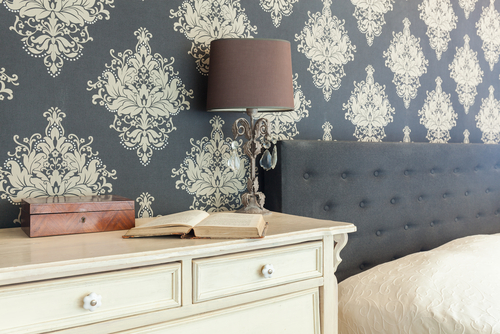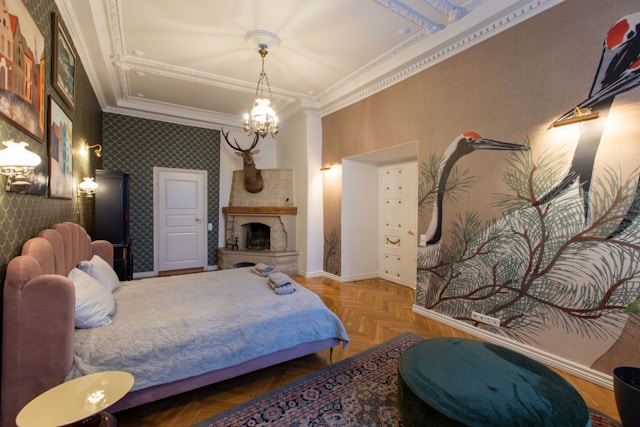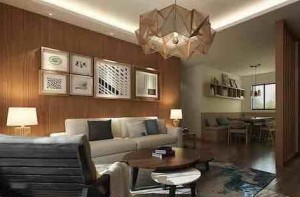Whilst wallpaper is definitely not as popular in its original form as it once was, it has a long history, having been used in England and Western Europe since the sixteenth century. The earliest known fragment of European wallpaper was found in Christ’s College in Cambridge in the United Kingdom and dates back to 1509. In the 1600’s, well before automation and bulk-printing processes were even thought of, wallpaper was block-printed and hand-coloured, and usually resembled damask materials. The Chinese had been hanging decorated rice-paper on their walls long before this. By some estimates, it appears that the Chinese were using a form of as early as 200 BCE, when plain rice paper was used to line their walls. By the early 17th century the Chinese had advanced to printing rice-paper panels with birds, flowers and landscapes, a trend which was soon followed by other nations.

Moving forward
The 17th century also saw the invention of flocked wallpaper, which was patterned or coloured wallpaper covered in adhesive in specific areas which were then sprinkled with dyed sheep wool trimmings, resulting in a richly textured finish similar to cut velvet.
The following two centuries saw increasing popularity in the use of wallpaper, particularly as designers became more inventive in their styles and designs, and often included scenes in their wallpapers. American and French wallpapers depicted the revolutions of 1776 and 1789, and the Great Exhibition of 1851 introduced many commemorative designs.
Introduction of industrial wallpaper production
The 19th century brought many technological developments in many areas of life. The first machines for printing wallpaper were introduced in the late 18th century and refined in the 19th century. Quicker and cheaper methods of printing wallpaper were developed in the mid 1800’s with the introduction of steam power. Industrial methods were developed for printing multiple colors. By 1850 8 colours were being printed and twenty years later 20 colours were being offered. Strangely enough, this proved to be largely unpopular, due to poor design offerings including “trompe l’oeil”, panoramic scenes and representations of textiles and architecture, which were mostly shunned in favour of flat, two-dimensional patterns featuring flora and fauna which originated from pre-industrial prototypes created by manual labour. Certainly, in the design world, moving forwards into mass-production and a wider colour selection in a fairly short space of time resulted in unforeseen disadvantages. Much of this was also due to the relatively inferior quality obtained through early mass production methods.
Different Wallpaper Applications
The application of wallpaper also began to change during the 19th century, moving away from one single pattern being chosen for all walls in a room, which could look overly ‘busy’ to the eye, clash with other furnishings, or make rooms unnecessarily fussy in appearance. It became popular for walls to be divided into three vertical sections, being the dado (floor to chair rail height), the filler – which ran from the top of the dado to the picture rail – and the topmost section known as a ‘frieze’ or border. Nowadays, we no longer have picture rails in our homes, although there are still some decorating styles which make use of dado rails which are either decorative or wooden horizontal mouldings at waist height which serve to protect the walls from damage by furniture accidentally hitting or banging into the walls.
Introduction of photography in designs
Although wallpaper was still a popular choice during the beginning of the 20th century, it was largely ousted due to mid-century Modernism which called for plain white walls and a certain amount of minimalism. Even so, advances continued in wallpaper production and techniques, resulting in more durable wallpapers, better dyes and colour control and easier application and removal of wallpaper. With the continual improvement in printing processes, and particularly into large-format digital printing, wallpapers are steadily coming back into modern decorating schemes, not only in our homes, but also in our business, hospitality, medical and retail sectors. Many walls now have life-sized floor-to-ceiling photographic scenes which bring the outside into the spaces within. In the Western Cape, for instance, you are likely to see mountain and vineyard scenes predominating large wall spaces, especially in the waiting and reception areas of medical centres. Not only are such scenes attractive, but they also relieve a lot of emotional anxiety as the mind focuses on more pleasant things instead of dwelling on the rather worrying present. Many business premises have also opted for scenic backgrounds or murals in their reception areas, rather than one-colour walls or patterned wallpaper. On a personal level, I absolutely love the idea of extending your focus onto something beautiful like a wooded path, a palm-fringed beach, a beautiful garden or park, or a night-lit city skyline and furnishing to suit the vista. Now that our homes are becoming smaller, wallpaper once again comes to the rescue in visually ‘extending’ our living areas beyond our rather tight four walls. If this does not appeal, wallpapers also come in realistic looking brick, wood or stone patterns which trick the eye into believing that there is a further element of architectural design in the room – and at a much lower cost! A scenic wallpaper, which is properly and adequately protected from the elements, can be used on a blank outside patio wall to give a further impression of space beyond the boundaries of the wall. For instance, imagine the life-size image of a garden, which could be ‘framed’ with a wooden pergola border, making you think that there is a further garden beyond the pergola. Whilst you won’t have the option of actually entering the garden, it will give an immediate sense of openness and space, both of which are highly valued in our modern environments.
It’s clear – wallpaper will always have its place in our lives
It is clear that wallpaper will always have a place in our lives, and for very good reason. Its popularity will, naturally, come and go according to the dictates of architectural and home design trends, but there is no doubt that it will evolve along with these trends. If it has been around since the 17th century in its most basic form, there is no doubt as to its staying power. If you are looking for design inspiration, there is always wallpaper to inspire you. Look to Uptasker if you want to find wallpaper specialists in your immediate area. You really WILL be doing yourself – and your environment – a favour!

